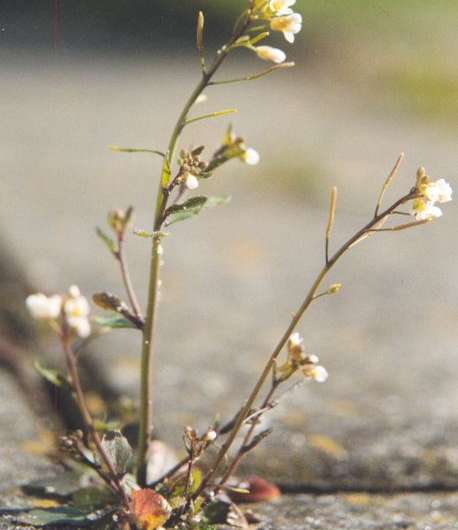This article has been reviewed according to Science X's editorial process and policies. Editors have highlighted the following attributes while ensuring the content's credibility:
fact-checked
peer-reviewed publication
trusted source
proofread
Researchers fill the final gaps in the Arabidopsis genome sequence

Arabidopsis thaliana is a species grown worldwide for genetic research and was the first plant to have its complete set of chromosomes (its genome) sequenced.
The initial genome sequence, released in the year 2000, had numerous gaps, but technological improvements in the years since closed the gaps, one by one, until only two remained: large undefined regions on chromosomes 2 and 4 where genes encoding ribosomal RNAs are repeated in hundreds of copies.
These ribosomal RNA gene clusters, known as nucleolus organizer regions (NORs), are not just difficult to define in Arabidopsis; gaps remain at the NORs in the genome sequences of nearly all eukaryotes (organisms whose cells have a nucleus), including humans. This has stymied studies of the NORs, and the genes within them, which encode the RNAs of ribosomes, the protein-synthesizing machines of all living cells.
The ribosomal RNA genes are regulated in ways that are not fully understood. For instance, they are known to be under epigenetic control, meaning that they can be turned on or off in a manner that does not depend on their sequence, but it is not clear how. And mis-regulation of the genes occurs in many cancers.
As a result, an understanding of ribosomal RNA gene regulation has long been a focus of biomedical research funding, which includes studies in plants, yeast, fruit flies, mice and other model organisms.
A new study, published in Science Advances, reports the complete sequences for the two Arabidopsis NORs and how active and silent ribosomal RNA genes are distributed throughout the NORs. The paper was authored by postdoctoral researchers Dalen Fultz, Anastasia McKinlay and Ramya Enganti in the laboratory of Craig S. Pikaard, an Investigator of the Howard Hughes Medical Institute and a Distinguished Professor, and Carlos O. Miller Professor, in the Departments of Biology and Molecular and Cellular Biochemistry at Indiana University Bloomington (IUB). Previous studies by the lab had shown that active and silent ribosomal RNA genes subtypes co-exist but associated with different NORs, based on genetic tests.
The new study identified more than 70 different gene subtypes, based on subtle differences, that are located either at NOR2 or NOR4, but not both. Knowing the physical positions of all of these subtypes, the authors conducted tests to determine whether each subtype was turned on, to make ribosomal RNA, or turned off. They also tested what happens in genetic mutants that are unable to silence their ribosomal RNA genes.
What they found was that one NOR is nearly completely silenced in growing plants, whereas the other NOR accounts for almost all ribosomal RNA gene activity—but only in its central region. Regions of high gene activity were found to correlate with regions where chemical modification of the DNA (by addition of single carbon methyl groups) is low and where neighboring genes tend to be of the same subtype.
The results provide the first glimpse of how ribosomal RNA genes are organized and regulated in the context of complete NORs. Because NORs also differ in activity in other species, including humans and fruit flies, the plant studies provide insights with broad biomedical relevance. The studies also pave the way for future studies in Arabidopsis aimed at understanding NOR epigenetic control and evolution, especially the newly-identified correlation between gene activity and gene subtype homogenization.
More information: Dalen Fultz et al, Sequence and epigenetic landscapes of active and silent nucleolus organizer regions in Arabidopsis, Science Advances (2023). DOI: 10.1126/sciadv.adj4509
Journal information: Science Advances
Provided by Indiana University





















